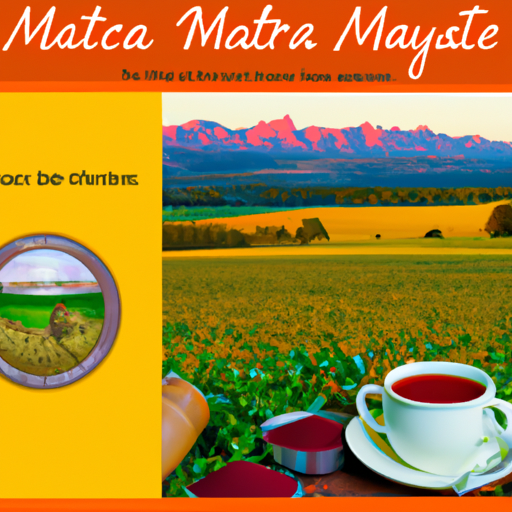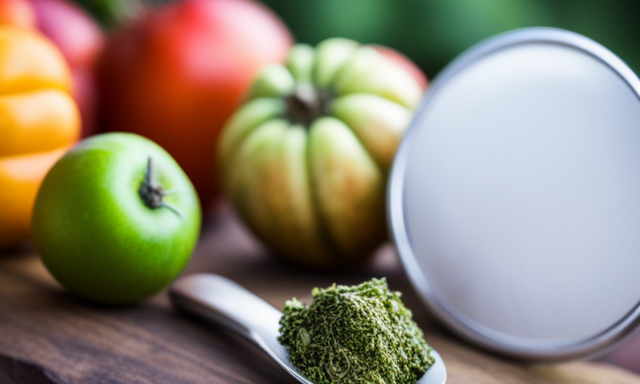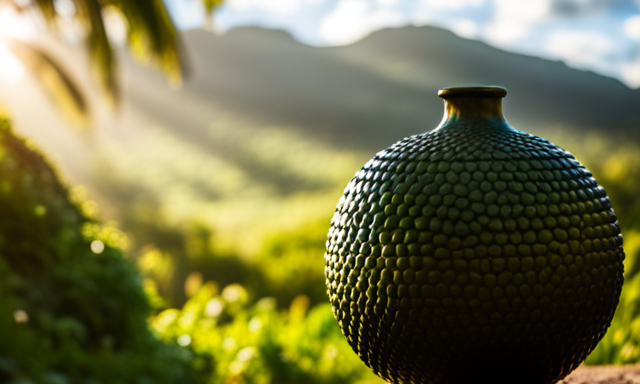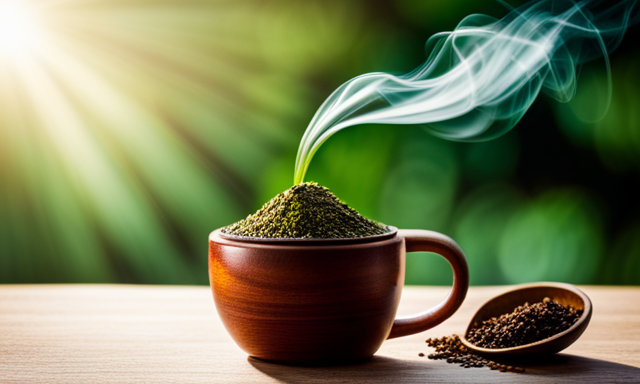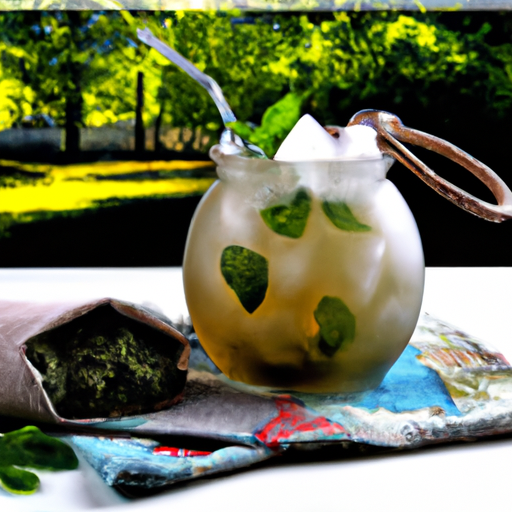I’ve always loved tea, yet my palate was pleasantly surprised when I stumbled upon yerba mate. This beverage from South America offers a distinct taste that’s both rejuvenating and stimulating. However, given the plethora of options available, selecting the right one can seem daunting.
In this article, we’ll explore the history of yerba mate, the different types available, how it’s harvested and processed, what to look for when choosing yerba mate, its health benefits, preparation methods and serving suggestions.
Yerba mate has been enjoyed in South America for centuries and was traditionally consumed by indigenous tribes as part of their cultural rituals. Today it’s still widely popular throughout the region and has gained worldwide recognition for its various health benefits such as boosting energy levels and aiding digestion. However, not all yerba mates are created equal – each type has its own distinct characteristics that make it stand out from the rest.
Whether you’re new to yerba mate or an avid fan looking to try something new, this guide will help you choose the best variety suited to your preferences.
Key Takeaways
- The quality of yerba mate is crucial in determining the flavor experience, and different processing methods can affect taste. Leaves are graded as con palo, sin palo, or despalada.
- Traditional preparation involves using a gourd and bombilla, but there are other options such as French press or bottled yerba mate. Serving suggestions vary by personal preference and cultural background.
- Yerba mate has various health benefits, including boosting energy levels, aiding digestion, enhancing mental clarity, and aiding in weight loss. It is also an integral part of South American culture and is often shared among friends and strangers.
- Yerba mate pairs well with light snacks like fruit salads or yogurt bowls, as well as spicy or salty foods and traditional South American dishes. The price range for yerba mate varies, and value for money depends on personal preference.
Brief History of Yerba Mate
Yerba mate, a traditional South American drink, has a rich and fascinating history that dates back to the indigenous Guarani people. They used the plant for medicinal and social purposes, believing that drinking yerba mate could cure various ailments like headaches, fever, and even depression. They also saw it as a symbol of unity and friendship, often sharing the drink with one another during communal gatherings.
As European colonization spread throughout South America in the 16th century, yerba mate became increasingly popular among colonizers. It soon became a cultural phenomenon associated with socialization and hospitality. Yerba mate was not only seen as a refreshing beverage but also as an important part of daily life that brought people together.
Today, yerba mate remains an integral part of South American culture and is enjoyed by millions around the world. Its cultural significance can be seen in its traditional preparation method called ‘cebar,’ where one person prepares and serves the drink to others in a ceremonial manner.
With such deep roots in history and tradition, it’s no wonder why yerba mate continues to be one of the most loved beverages worldwide.
Moving on to types of yerba mate…
Types of Yerba Mate
You’ll find that there are different varieties of this energizing beverage, each with its own unique flavor profile. Yerba mate blends can be categorized into two main groups: traditional and modern preparations. Traditional yerba mate is prepared in a gourd or cup called a mate, using a bombilla (a special straw) to drink the infusion. This method has been used for centuries by indigenous people in South America and is still widely used today.
On the other hand, modern yerba mate preparations include mixes with other herbs and flavors such as mint, citrus fruits, ginger, and even chocolate. These blends are often packaged in tea bags or loose leaf form for convenience. While some purists may argue that these blends deviate from the traditional way of drinking yerba mate, they offer consumers more options to customize their experience.
To help you navigate the world of yerba mate blends, here’s a table showcasing some of the most popular types available:
| Type | Description | Flavor Profile |
|---|---|---|
| Traditional Argentine | Strong flavor with smoky undertones | Bold and earthy |
| Brazilian Chimarrão | Mild taste with grassy notes | Fresh and vegetal |
| Paraguayan Tereré | Served cold with lime juice or fruit extracts | Refreshing and citrusy |
| Modern Mint Blend | Yerba mate mixed with peppermint leaves | Cool and refreshing |
As you can see from the table above, there’s a wide range of flavors to choose from when it comes to yerba mate. In the next section, we’ll explore these flavor profiles in more detail so you can better understand which one suits your taste buds best.
Flavor Profiles
As a yerba mate lover, I always look forward to exploring the different flavor profiles of this South American beverage.
There are three main flavor categories that stand out: Earthy and Bold, Sweet and Light, and Smoky and Robust. Each profile offers a unique taste experience that can cater to different preferences or moods.
In this discussion, we’ll dive deeper into these flavors and explore what makes them distinct from each other.
Earthy and Bold
Bold blends bring big bursts of beautiful, bountiful flavor to your beverage. If you’re a fan of earthy and robust flavors, then you’ll love trying yerba mate that’s been roasted or smoked. These techniques give the leaves a deeper, more complex taste that’s perfect for those who enjoy strong coffee or dark chocolate.
When it comes to brewing techniques, I recommend using hot water and letting the mate steep for at least 3-5 minutes to fully extract the flavor. If you prefer your drink sweeter, you can add honey or sugar to balance out the bitterness. However, if you’re looking for a purer taste experience, try sipping it without any additives first to see how you like it.
Moving on from earthy and bold flavors, let’s dive into the next subtopic: sweet and light blends.
Sweet and Light
Get ready to indulge in a delightful and refreshing experience with sweet and light yerba mate blends. These types of yerba mate are perfect for those who prefer a milder taste profile that is easy on the palate.
Here are some great options to try out:
- Lemon-flavored blends: The tangy citrus flavor of lemon pairs perfectly with the natural sweetness of yerba mate, creating a bright and uplifting brew.
- Mint-infused blends: The cool freshness of mint adds a soothing touch to the sweet notes in yerba mate, making it an ideal choice for relaxation.
- Fruit-based blends: Fruity flavors like peach or raspberry provide a subtle sweetness that complements the grassy undertones of yerba mate, resulting in a deliciously balanced cup.
- Vanilla-infused blends: The smooth and creamy aroma of vanilla enhances the natural sweetness in yerba mate, creating a warm and comforting drink.
To get the most out of these sweet and light yerba mate blends, try brewing them at lower temperatures (around 160°F) for shorter periods (3-5 minutes). This will help bring out their delicate flavors without overpowering them.
As for pairing suggestions, these types of mates go well with light snacks like fruit salads or yogurt bowls.
Moving on to our next subtopic about ‘smoky and robust’, let’s explore some bolder options for those who crave more intense flavors.
Smoky and Robust
If you’re looking for a yerba mate with a strong and smoky flavor, there are plenty of options to choose from that will satisfy your palate. Smoky blends are known for their bold taste and robust flavors, making them the perfect choice for those who enjoy a more intense drinking experience.
Some popular smoky blends include La Tranquera Seleccion Especial and Cruz de Malta Traditional.
Robust flavors can be achieved through different processing methods, such as the use of wood-fired drying or aging techniques. These processes add depth and complexity to the flavor profile of yerba mate, resulting in a rich taste that lingers on the tongue.
If you’re interested in learning more about how yerba mate is harvested and processed to achieve these unique flavors, keep reading into the subsequent section.
Harvesting and Processing
You’ll smell the sweet aroma of freshly harvested yerba mate leaves as they’re carefully picked and dried under the hot sun before being expertly processed into your favorite blend.
The techniques used for harvesting yerba mate are crucial in determining its quality. The best yerba mate is harvested by hand, ensuring that only the most mature leaves are selected.
After harvesting, the leaves undergo a complex process where they are dried, sorted, and aged to enhance their flavor profile. Different processing methods can affect the final taste of the drink.
For example, some yerba mate producers prefer to smoke-dry their leaves over a wood fire to impart a smoky flavor. Others prefer air-drying or heat-drying methods for a more balanced taste.
Choosing high-quality yerba mate can be overwhelming with so many options available. However, understanding how it’s harvested and processed can help you make an informed decision about what type of blend is right for you.
In the next section, we’ll discuss what to look for when choosing yerba mate beyond just its taste profiles.
What to Look for When Choosing Yerba Mate
When I’m choosing yerba mate, there are three key things I look for: the quality of leaves, packaging and brand, and price point.
First off, high-quality leaves are essential for a flavorful and satisfying cup of mate. I always check to make sure the leaves are fresh and green with minimal dust or stems.
Next, packaging and brand can also play a big role in the overall experience. Look for reputable brands with sustainable practices and packaging that keeps the mate fresh.
Finally, while price isn’t everything, it’s important to find a balance between quality and affordability when selecting your yerba mate.
Quality of Leaves
The quality of yerba mate leaves greatly affects the overall taste and experience of drinking it. When choosing yerba mate, it’s important to pay attention to leaf grading. The higher the grade, the better the quality of the leaves.
In general, there are three main grades: con palo, sin palo, and despalada. Con palo means ‘with stem,’ sin palo means ‘without stem,’ and despalada means ‘stemless.’ Sin palo is considered to be the highest quality because it contains only leaves and no stems.
Brewing techniques also play a role in determining the quality of yerba mate. The temperature of the water used for brewing should be around 170-180°F (77-82°C) to avoid burning or over-extracting the leaves. It’s essential not to use boiling water as it can destroy some of the nutrients present in yerba mate leaves. Also, steeping time should be monitored carefully as over-steeping can result in a bitter taste.
By keeping these factors in mind when selecting and preparing your yerba mate, you can ensure that you’ll have an enjoyable drinking experience with rich flavor and aroma. Moving on from discussing leaf grading and brewing techniques, another crucial aspect that determines a great yerba mate experience is packaging and brand selection.
Packaging and Brand
If you want to ensure a consistent and satisfying yerba mate experience, it’s important to select a brand and packaging that suits your preferences. When it comes to choosing the right packaging, there are several factors to consider. For instance, some brands offer resealable bags or tins that help keep the leaves fresh for longer. Others come in convenient tea bags that are perfect for on-the-go brewing.
Aside from packaging, it’s also worth looking into the brand’s sustainability practices. Many companies now prioritize eco-friendly production methods and use of recyclable materials in their packaging. Additionally, reading customer reviews can give insight into the flavor profile of different brands and whether they align with your taste preferences. By taking these factors into consideration, you can choose a yerba mate brand and packaging that not only satisfies your taste buds but also aligns with your values. Now let’s move onto discussing how price point plays a role in selecting the best yerba mate.
Price Point
As I mentioned in the previous section, packaging and brand can play a big role in choosing yerba mate. However, once you’ve found some brands that appeal to you, it’s time to consider the price point. Yerba mate can range from affordable to quite expensive depending on factors such as quality, quantity, and origin.
When considering price range for yerba mate, it’s important to weigh the value for money. Cheaper yerba mate may be more accessible on a day-to-day basis but could contain lower quality ingredients or less of the desired effects. On the other hand, more expensive options may offer higher quality or a unique experience but aren’t always practical for regular consumption.
When looking for value for money in yerba mate, consider these two sub-lists:
-
What is my budget? Determine how much you’re willing to spend on yerba mate and stick within that range.
-
How often will I drink it? If you plan on drinking yerba mate every day or multiple times per week, investing in a slightly pricier option with better quality might be worth it.
Ultimately, the decision comes down to personal preference and priorities – whether that means prioritizing cost efficiency or splurging on higher quality product occasionally.
Now that we’ve explored packaging/brand and price point considerations when choosing yerba mate, let’s dive into the health benefits of this popular South American beverage!
Health Benefits of Yerba Mate
Let’s explore how yerba mate can boost your health with its impressive array of benefits. Yerba mate has been used for centuries in South America as a medicinal herb and is known to have numerous health benefits.
One of the most well-known benefits of yerba mate is its ability to aid in weight loss. It contains compounds that can increase metabolism, suppress appetite, and improve insulin sensitivity.
In addition to aiding in weight loss, yerba mate also has properties that can enhance mental clarity. The caffeine content in yerba mate provides an energy boost without the jitters or crash associated with coffee consumption. It also contains theobromine and theophylline, which are both stimulants that can improve cognitive function and focus. These compounds work together to create a state of alertness and mental acuity.
When it comes to preparing yerba mate, there are several different methods you can use depending on your personal preference. From brewing it traditionally using a gourd and bombilla to using tea bags or even making it into iced tea, there are many ways to enjoy this healthy beverage.
So let’s move on to exploring the different preparation methods for enjoying this delicious drink!
Preparation Methods
Now that we know about the various health benefits of yerba mate, let’s dive into the different ways to brew this traditional South American beverage. Yerba mate brewing is a centuries-old practice that involves using special utensils to make the perfect cup. Personally, I find it fascinating how much dedication and care goes into making each serving.
The most common way to prepare yerba mate is by using a gourd (called a ‘mate’) and a bombilla (a metal straw with a filter at one end). First, fill the mate with loose-leaf yerba mate until it’s about two-thirds full. Then pour hot water over the leaves and let it sit for 30 seconds before inserting the bombilla and sipping through it. This method requires patience and precision but yields an authentic taste.
If you’re not keen on using traditional utensils, don’t worry! There are other ways to enjoy yerba mate without compromising on flavor. You can use a French press or tea infuser to steep the leaves in hot water, or opt for ready-to-drink bottled options if you’re always on-the-go. The key is finding what works best for you while still appreciating the cultural significance of yerba mate brewing.
Now that we’ve explored different preparation methods for yerba mate, let’s move onto serving suggestions.
Serving Suggestions
To fully enjoy the rich flavor and cultural significance of this beloved South American beverage, you may want to consider serving yerba mate with traditional accompaniments like sweet pastries or savory empanadas.
Serving suggestions for yerba mate can vary depending on your personal preference and cultural background. For example, in Argentina, they commonly serve their yerba mate with facturas – sweet pastries similar to croissants – while in Uruguay, it is common to pair it with a slice of cake or bread.
If you’re looking for something more savory, try pairing yerba mate with empanadas or other small bites like cheese and crackers. The bold flavor profile of yerba mate pairs well with spicy or salty foods, making it an excellent addition to any appetizer spread.
Additionally, serving yerba mate alongside traditional South American dishes like asado (grilled meats) or feijoada (a Brazilian bean stew) can provide a well-rounded culinary experience.
Overall, there are many serving suggestions and pairing options when it comes to enjoying yerba mate. Whether you prefer sweet or savory flavors, there’s sure to be a combination that suits your taste buds.
Now that we’ve explored some delicious ways to enjoy this beverage, let’s delve into the cultural significance of yerba mate in South America.
Yerba Mate and Culture
When it comes to yerba mate, its cultural significance can’t be ignored.
As someone who’s always been fascinated by the customs and traditions of different cultures, I find it interesting to learn about how this social drink is enjoyed in South America.
Yerba mate ceremonies are a common sight in countries like Argentina and Uruguay. It’s fascinating to see how such a simple beverage can bring people together in such a meaningful way.
With the rise of health-consciousness and the popularity of natural remedies, yerba mate has found its place in the modern world as a healthy alternative to coffee or tea.
Social Drink in South America
You can’t visit South America without experiencing the social drink that is yerba mate, passed around and shared amongst friends and strangers alike, creating a sense of community and connection. The societal significance of sharing yerba mate dates back centuries in South American culture, where it serves as a symbol of hospitality and friendship.
To fully understand the cultural traditions surrounding yerba mate, it’s important to know some key facts about how it’s traditionally consumed:
- Yerba mate is typically served in a gourd or cup with a metal straw called a bombilla.
- The host prepares the drink by filling the gourd with yerba leaves and hot water before passing it around for each person to sip through the bombilla.
- It’s common to share one gourd among several people during a meeting or gathering.
These customs make sharing yerba mate not only an enjoyable experience but also an important aspect of socializing in South America. As you continue learning about this beloved beverage, you’ll discover that there are even more fascinating aspects to explore – such as the various ceremonies related to drinking yerba mate.
Yerba Mate Ceremonies
Get ready to immerse yourself in the rich cultural traditions of South America with yerba mate ceremonies, where the preparation and sharing of this beloved beverage becomes a sacred ritual. Yerba mate gourd is at the center of these ceremonies, which are often shared among friends or family members. Traditional yerba mate preparation involves filling the gourd with loose-leaf yerba mate and adding hot water. The drink is then sipped through a metal straw called a bombilla.
Yerba mate ceremonies are not only about enjoying a delicious beverage but also about socializing and connecting with others. It is customary for participants to pass around the gourd, each taking turns sipping from it. This practice symbolizes unity and friendship among those who share in this special moment together. As someone who has participated in yerba mate ceremonies myself, I can attest to the sense of community that comes from sharing this traditional drink with loved ones.
As we move into exploring yerba mate in the modern world, it’s worth noting that while traditional preparation methods remain an integral part of South American culture, there are now many innovative ways to enjoy this beverage beyond just using a gourd and bombilla.
Yerba Mate in the Modern World
Nowadays, it’s fascinating to see how yerba mate has evolved and become a part of mainstream culture, igniting curiosity and excitement among new generations.
Yerba mate consumption is on the rise due to its numerous health benefits, such as boosting energy levels, improving digestion, and enhancing mental clarity. It has also become a popular alternative for those looking for a healthier caffeine fix than coffee or energy drinks.
Furthermore, yerba mate production trends have been changing in response to this growing demand. The traditional South American method of producing yerba mate involves drying the leaves using wood smoke, which gives it a distinct smoky flavor. However, modern production methods now involve using hot air instead of smoke, resulting in a smoother taste that appeals to wider audiences.
Additionally, more companies are beginning to offer flavored yerba mate blends that cater to different tastes and preferences. Overall, the increasing popularity and evolving production techniques make it an exciting time for yerba mate enthusiasts all over the world.
Frequently Asked Questions
How long has yerba mate been consumed and where did it originate?
As someone who’s always been interested in the history and culture of different beverages, I can tell you that yerba mate has a long and rich past.
Originating in South America, specifically in the region now known as Paraguay, it was first consumed by indigenous tribes for its medicinal properties. Over time, it became a social drink among these tribes and eventually spread throughout the continent.
With the arrival of European colonizers came commercialization and mass production of yerba mate, leading to its popularity around the world today. Its cultural significance is still evident today as it remains an important part of daily life in many South American countries, often shared among friends and family during gatherings.
Overall, understanding the history and culture behind yerba mate only adds to its appeal as a beloved beverage with a fascinating story to tell.
Are there any negative side effects to drinking yerba mate?
There are potential risks associated with drinking yerba mate, primarily due to its caffeine content. Some people may experience adverse effects such as jitteriness, insomnia, or increased heart rate.
In addition, yerba mate may interact with certain medications and should be avoided by individuals taking monoamine oxidase inhibitors (MAOIs) or stimulant medications. It’s important to consult with a healthcare professional before consuming yerba mate if you have any health concerns or take prescription medications.
However, when consumed in moderation and with caution, yerba mate can provide several health benefits such as improved cognitive function and increased energy levels.
Can yerba mate be used for cooking or baking?
When it comes to yerba mate, there are plenty of ways you can incorporate it into your cooking and baking. I’ve found that using yerba mate as a rub for meats or sprinkling it on roasted vegetables can add an earthy, slightly smoky flavor to dishes.
You can also steep the leaves in milk or cream before using them in custards or ice creams. One adage that comes to mind is ‘variety is the spice of life,’ and this definitely applies when experimenting with yerba mate in the kitchen.
Whether you’re trying out new marinades or adding a bit of mate to your favorite baked goods, there are plenty of recipe ideas out there to explore. Just be sure to use high-quality leaves from a reputable source, and consider grinding them up for easier use in recipes.
Overall, there’s no shortage of ways to get creative with yerba mate when cooking and baking!
Is there a difference in quality between loose leaf and tea bag yerba mate?
When it comes to yerba mate, there’s definitely a difference in quality between loose leaf and tea bag varieties. Loose leaf yerba mate typically has a richer flavor profile and aroma compared to its pre-packaged counterpart.
This is because the leaves are less processed and more intact, allowing for a fuller extraction of the flavors and nutrients during brewing. In contrast, tea bag yerba mate may have a slightly muted taste due to the finer grind of the leaves and limited space for expansion within the bag.
That being said, tea bags are certainly more convenient for on-the-go or quick brewing situations. Ultimately, it’s up to personal preference whether one prioritizes taste or convenience when choosing between loose leaf vs tea bag yerba mate.
Can yerba mate be blended with other herbs or teas for added flavor or health benefits?
Herbal infusions have been used for centuries to promote health and wellness. Yerba mate, in particular, is a popular choice due to its numerous benefits such as increased energy and mental clarity. However, some may find the taste of plain yerba mate too strong or bitter.
That’s where yerba mate blends come in. By combining yerba mate with other herbs or teas, you can create a delicious beverage with added health benefits. For example, adding mint leaves can help soothe digestive issues while ginger can aid in reducing inflammation.
According to a survey conducted by the National Center for Complementary and Integrative Health, approximately 18% of adults in the U.S use herbal supplements such as yerba mate blends for their health benefits. So if you’re looking for a tasty way to incorporate more herbal infusions into your routine, consider trying out some yerba mate blends!
Conclusion
Well folks, after all the research and taste-testing, I’ve come to a conclusion on the best yerba mate out there.
But before I reveal my top pick, let’s recap what we’ve learned about this beloved South American beverage.
Yerba mate has a rich history dating back centuries and comes in various types with distinct flavor profiles. The harvesting and processing methods can also affect the taste and quality of the final product.
When choosing yerba mate, it’s important to look for certain characteristics such as freshness and cut size. And let’s not forget about the numerous health benefits that come with drinking this magical brew.
Now, without further ado, my personal favorite yerba mate is… just kidding! Who am I to tell you what the ‘best’ yerba mate is? Taste is subjective and everyone has their own preferences.
So go out there and try different kinds for yourself! Don’t be afraid to experiment with preparation methods and serving suggestions either. After all, half the fun of drinking yerba mate is discovering new ways to enjoy it.
In all seriousness though, I hope this article has provided some helpful insights into the world of yerba mate. Whether you’re a seasoned pro or new to this wonderful drink, there’s always more to learn and appreciate about it.
So sit back, relax with a gourd full of your favorite blend, and enjoy all that yerba mate has to offer (with moderation of course).


